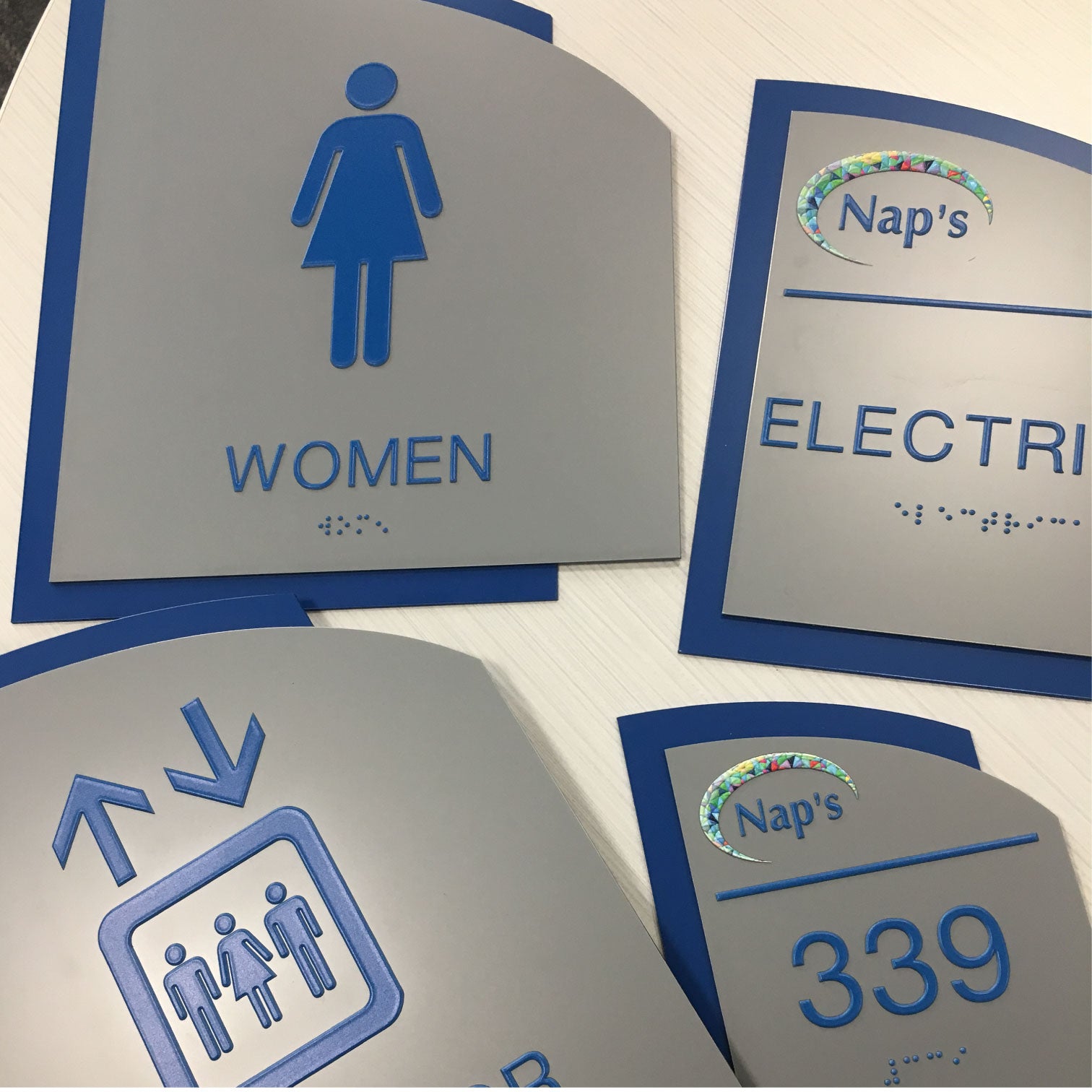ADA Signs: Making Sure Ease Of Access and Compliance in Public Spaces
ADA signs plays an indispensable function in ensuring availability and conformity within public areas, considerably adding to a comprehensive atmosphere for people with specials needs. As we check out the subtleties of ADA signs, from responsive features to make complexities, it's important to take into consideration exactly how these aspects integrate to maintain the legal rights of all individuals.
Significance of ADA Signage
In modern society, the significance of ADA signage expands past simple compliance with lawful requireds to embody a dedication to inclusivity and access for all people. These indications are vital in developing settings where individuals with impairments can navigate public rooms with the exact same ease and self-reliance as those without specials needs. By offering clear and standardized info, ADA signage makes certain that everyone can access centers, solutions, and information without obstacles.
The value of ADA signage exists in its capability to improve the lifestyle for people with handicaps by promoting equivalent gain access to. It eliminates the obstacles that might otherwise prevent their capacity to get involved fully in community life. These indications serve as visible signs of a company's commitment to diversity and equality, mirroring wider social values that champion the civil liberties and dignity of all people.
Furthermore, ADA signs plays an important role in public safety. By guiding people to leaves, washrooms, and various other important centers, it ensures that all people, despite physical capacity, can evacuate safely throughout emergency situations. In summary, ADA signage is not just a governing need but an effective device for fostering a inclusive and equitable culture.
Key Components of Conformity

Placement is important; signs must be installed in locations that are easily noticeable and obtainable. Usually, signs needs to be placed between 48 and 60 inches from the ground to make sure access for both standing and mobility device customers. Responsive aspects, such as Braille, are vital for individuals with visual problems, giving crucial details in a non-visual layout.
High-contrast shades between the message and history are required to enhance readability for individuals with low vision. The ADA mandates specific comparison ratios to guarantee quality. In addition, character dimension is a crucial consideration, with minimal height requirements determined by the seeing range to guarantee readability from numerous angles.
Style Considerations for Access
Creating obtainable signs needs a careful technique to ensure it meets the demands of all individuals, especially those with specials needs. This includes considering different layout aspects that boost readability and functionality. Trick aspects include the selection of font, shade comparison, and tactile attributes. Typefaces ought to be sans-serif, with basic and clear letterforms, to facilitate simple analysis. The dimension of the text is equally critical, with ADA standards recommending a minimal elevation based on seeing range to make sure clarity.
Contrasting colors in between message and background are necessary for exposure, especially for individuals with visual problems. Furthermore, tactile elements, such as Braille and elevated personalities, are crucial for individuals who read this post here are blind or have reduced vision.
Additionally, the placement of signs plays a substantial function in availability. Indications should be mounted in places that are unblocked and easily obtainable. Making certain that signage is placed at ideal heights and angles enables all customers, including those using mobility devices, to communicate with them successfully.
Typical Blunders to Prevent

One more common error is the inaccurate placement of signage. ADA standards specify exact height and place demands to make sure that signs are conveniently visible and obtainable by all people, including those making use of wheelchairs. Neglecting these guidelines not only interferes with ease of access however additionally runs the risk of non-compliance with lawful standards.
Furthermore, not enough contrast between message and background is a regular oversight. Ample contrast is vital for readability, specifically for individuals with low vision. Designers often pick colors that are visually attractive but lack the required comparison, providing the text challenging to discern.
Last but not least, some designers stop working to include responsive elements, such as Braille, which are vital for people that are blind. Leaving out these features not only leads to non-compliance with ADA guidelines yet additionally limits access for a segment of the population that relies upon tactile information.
Future Trends in Signage
Developments in innovation and boosting recognition of inclusivity are forming the future patterns in signage design. As society becomes more conscious of varied demands, the assimilation of clever technologies into signs is obtaining grip. Digital signs, for instance, is developing to include interactive features and real-time updates, which can be critical in offering dynamic info in public spaces. These signs often integrate touch displays or gesture-based controls, making it possible Recommended Reading for individuals to navigate material customized to their particular requirements.
Another arising trend is the use of augmented fact like this (AR) to enhance individual experience. AR-enabled signs can overlay digital details onto the physical environment, giving visually damaged people with auditory or haptic feedback. ADA Signs. This modern technology not only enhances availability however additionally creates an appealing experience for all customers
Sustainability is also a substantial factor influencing signs fads. Environment-friendly products and energy-efficient lighting options are being focused on to align with global environmental objectives. Advancements in materials science are leading to the advancement of even more sturdy and weather-resistant signs.
Conclusion
ADA signage plays an essential role in guaranteeing ease of access and compliance within public areas by integrating responsive aspects, high-contrast shades, and critical placement. The adherence to ADA standards not only helps with risk-free navigation for individuals with impairments however additionally symbolizes an organization's devotion to diversity and inclusivity. By preventing common errors and accepting future patterns, public areas can continue to advance these values, ensuring that the civil liberties and self-respect of all people are valued and promoted.
ADA signs plays an important function in ensuring ease of access and compliance within public spaces, considerably contributing to an inclusive setting for people with impairments. As we explore the nuances of ADA signs, from tactile features to develop complexities, it's important to consider just how these aspects coalesce to promote the legal rights of all individuals.In modern culture, the importance of ADA signs expands beyond plain conformity with legal requireds to embody a dedication to inclusivity and availability for all individuals. By giving clear and standardized info, ADA signage makes sure that everyone can access centers, services, and information without barriers.
ADA signs plays a crucial role in ensuring accessibility and conformity within public spaces by integrating tactile aspects, high-contrast shades, and calculated placement. (ADA Signs)
Comments on “The Advantages of Using Top Notch ADA Signs in Your Organization”